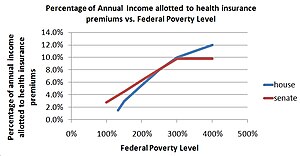
Image by Getty Images via @daylife
Last fall, author Michael Pollan wrote an op-ed in the New York Times offering a simple defense of the not-yet-passed healthcare reform proposal: It would push the health insurance industry to take more interest in America's obesity problem and use its influence to reshape agricultural and food policy, he argued.
Pollan is best known for writing The Ominovore's Dilemma, and played a large role in kick starting the growing "food consciousness" in America. What began as a few scattered academic arguments about obesity and agribusiness has now morphed into a movement, with reality television shows about eating fruits and vegetables and a campaign by First Lady Michelle Obama to reverse childhood obesity, in part by offering healthier food choices in schools.
And Pollan thinks insurers can be a champion for that movement. Although health insurers have long been aware of the burden of obesity and its connection to chronic diseases, until now they have had strategies for keeping certain high-risk patients out of their pool of customers. But because insurance companies can no longer exclude patients because of pre-existing conditions or other health indicators, preventing chronic disease is now a top business priority.
"A patient with Type 2 diabetes incurs additional healthcare costs of more than $6,600 a year; over a lifetime, that can come to more than $400,000. Insurers will quickly figure out that every case of Type 2 diabetes they can prevent adds $400,000 to their bottom line. Suddenly, every can of soda or Happy Meal or chicken nugget on a school lunch menu will look like a threat to future profits," Pollan wrote.
The argument is a little simplistic, and it isn't as if insurers aren't well aware of the costs associated with obesity. But he has a point. Maybe it's time for insurers to get more involved in preventing obesity at the national level.
What if the insurance industry threw its full weight behind a tax on soda and sugary drinks? Or lobbied for agricultural policy that brought down the cost of fruits and vegetables? Individual payers could even significantly increase their reimbursements for wellness and weight loss services, and hopefully see a return on that investment in a healthier America.
Savvy insurers are already taking innovative steps to incentivize weight loss and focus on prevention. But a recent study in the American Journal of Public Health suggests some may not yet be seeing the bigger picture. Companies providing health and life insurance own roughly $1.9 billion worth of stock in the fast-food industry, according to the study.
Granted, this was probably a drop in the bucket relative to their overall portfolios. But any individual or institution interested in improving Americans' health should think twice before investing in an industry that provides the cheap, unhealthy food that helps fuel the obesity epidemic.
The campaign by Mrs. Obama to reverse childhood obesity provides a perfect jumping in point. Partnering with the White House on this initiative could not only improve the health status of the industry's future customers, but it could also help repair its tarnished public image.
And ultimately, reversing these 30-year trends will not only be good for the nation. It will be essential to insurers' bottom lines, as well.

![Reblog this post [with Zemanta]](http://img.zemanta.com/reblog_e.png?x-id=81391880-6498-4fcd-ba9f-76d1ca408cbf)

![Reblog this post [with Zemanta]](http://img.zemanta.com/reblog_e.png?x-id=e0cd0af5-bfdd-474d-9415-4f197353a40e)
![Reblog this post [with Zemanta]](http://img.zemanta.com/reblog_e.png?x-id=77b6a2d9-cafa-4659-9350-c93560759859)

![Reblog this post [with Zemanta]](http://img.zemanta.com/reblog_e.png?x-id=61b132fc-fb07-4120-831a-78318c2a3ac5)
